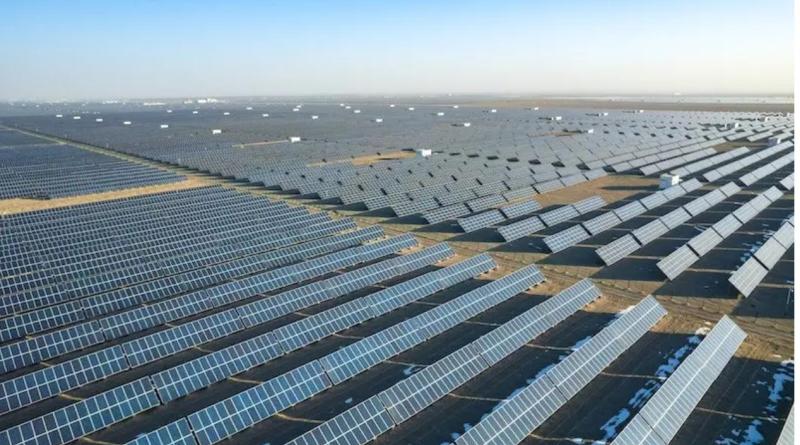Big Solar Outshines Big Oil as Emerging Giants Top ‘Powerhouses of Petroleum’

The world’s biggest solar manufacturers, all of them based in China, are delivering more usable energy each year than the top seven oil and gas companies, concludes a blockbuster analysis released earlier this month by Bloomberg News.
While the annual output from Tongwei Co., GCL Technology Holdings Ltd., Xinte Energy Co., Longi Green Energy Technology Co., Trina Solar Co., JA Solar Technology Co., and Jinko Solar Co. is more or less on par with familiar oil companies like Exxon, Chevron, Shell, and BP, the long-term power generation they’re installing each year “is well above what’s available in Big Oil’s geological reserves,” writes opinion columnist David Fickling.
Fickling takes his readers through a series of calculations to compare the oil and gas extracted each year with the new solar panels manufactured, then translates those top-line numbers into what end users actually need and want.
“The best way to think about this is to consider what oil companies ultimately provide the world,” he explains. “It’s not really crude or natural gas, but the vital ingredient locked up in the chemical bonds of those hydrocarbons: energy.” Similarly, solar manufacturers “aren’t in the final analysis providing us with panels of silicon and glass, but machines that can harvest power from the sun.”
Both sets of activities “provide a fresh flow of useful energy to the world every year,” he adds. “And by many measures, the solar companies have already overtaken Big Oil.”
Fickling reports that:
• The seven biggest privately-held oil companies that “powered the 20th century”—Exxon, Chevron, Shell, TotalÉnergies, BP, ConocoPhillips, and Eni—are still massive enterprises, collectively producing nearly 18 million barrels per day of oil, or the equivalent in natural gas or natural gas liquids.
• But fossil fuel production is incredibly inefficient at turning extracted product into energy that anyone can use. RMI estimated earlier this month that three-quarters of the energy from fossil fuels is wasted before it delivers any value, and Fickling agrees.
“Only about a fifth of the chemical energy in freshly pumped crude ends up being turned into kinetic energy moving cars and trucks, because oil refineries and vehicle engines fritter most of it away as useless heat and noise,” he writes. “Gas turbines are a bit more efficient at turning methane into power, but still end up operating at about one-third efficiency once you account for losses from gas well to electrical socket.”
• By contrast, the biggest solar manufacturers in China turn polysilicon raw material into solar cells that generate exajoules of energy, just as oil and gas does. (One exajoule of electricity would be enough to power Italy for a day, Fickling says.) After factoring in the efficiency of the two options, the solar companies’ production of usable energy doesn’t fall too far short of the fossil giants. If the leading solar manufacturer, Tongwei, decides to nearly double its current output by building a big, new polysilicon plant in Inner Mongolia, it’s annual output of useful energy might overtake ExxonMobil’s.
• But that’s not the whole story. Fickling looks at the energy that each group of producers can deliver before their current capital investments wear out—in the 10 years or so before an oilfield depletes, or the decades before the manufacturing equipment in a solar plant wears out or becomes obsolete. On that basis, “clean power moves clearly into the lead,” with seven solar companies showing up among the top 10 producers and four big oil and gas companies—Shell, ConocoPhillips, BP, and Eni—coming in last.
• Even that comparison is still “forgetting one more crucial factor,” Fickling writes. A solar panel sold in 2024 “will be generating electricity for decades. Most carry 25-year warranties. Oil and gas sold this year, however, will almost all be used up in a matter of months.” On that time scale, the seven top solar companies generate 110 exajoules of energy, compared to a mere 24 across the seven oil and gas giants.
These changes amount to “a remarkable shift,” Fickling writes. “Around the middle of the 20th century, the predecessors of the major international oil companies attained such power that they were nicknamed the Seven Sisters, a group of energy producers with such global scope and influence that they could make or break governments.”
While many of them are still trying very hard to do that, “seven Chinese companies have a bigger stake in the power source of the 21st century than the Seven Sisters of oil that dominated the 20th,” he notes. That shift helps explain the “geopolitical angst” in the United States, and now in Canada, surrounding the meteoric growth of clean technology in China.





